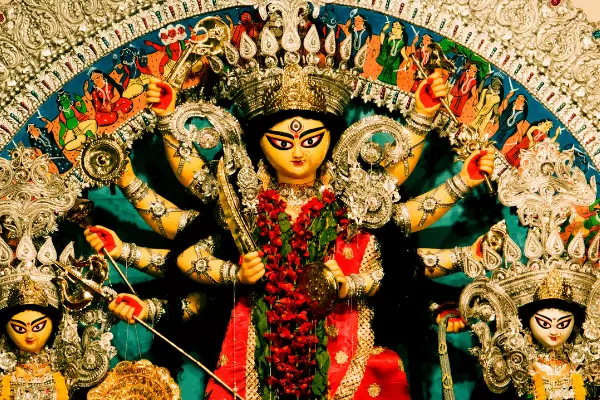For smooth Ad free experience
For smooth Ad free experience
A woman's loving nature shouldn't be mistaken for her weakness. Maa Chandraghanta, the third form of Parvati signifies peace, calm and purity but she is the Shakti of Lord Shiva. Her third eye will open during the time of war to protect her devotees and destroy all evil.

Celebrated every year
The 9 days of Durga Puja represents the 9 manifestations (roop) of Goddess Durga or Parvati. It is a tale as old as rhyme when Goddess Parvati assumed the form of a warrior-goddess in order to defeat a demon or asura called 'Durg' who was half-buffalo, half-demon, from where her avatar name 'Durga' arises. The demon also goes by the name Mahishasura and the goddess by the name Mahishasura Mardini for she kills the demon Mahishasura.
The first two days represents the form Shailaputri, the childhood days of Parvati and Brahmacharini, the asceticism phase of Parvati. We are into the third day of Durga puja which falls on the Tritiya Tithi of Chaitra, Shukla Paksha. The third day depicts Chandraghanta, the married aspect of Parvati. How did this form appear and what is its significance?
Parvati went through numerous obstacles and gruelling austerity to get Lord Shiva as her husband. She lived in the forest surviving on bare minimal to fulfil her motive. Finally, when her father found her, he agreed to her wishes and she and Lord Shiva got married. On the day of her wedding night, Parvati observed the moon on her husband's head. Mahadev adorns a crescent moon upon his crown of matted hair, which is why he is also known as Chandrashekhara. Realizing this, Parvati expressed her desire that she too wants to adorn the Moon of God on her forehead similar to his. Seems like matching couple getup is more of an ancient trend than one might believe it to be!
Another version of the story goes as follow. The King, father of Parvati agreed to her marriage with Lord shiva. However, on the day of the marriage, Lord Shiva arrived with a huge yet strange marriage procession. He was surrounded by ghosts, goblins and ghouls and Lord Shiva himself was adorned with multiple snakes around his whole body smeared with ash giving him a horrifying look. Parvati's family and relatives got extremely terrified of his form and started fainting.
Parvati realizing this, to protect her family transformed into a terrorizing form- Chandraghanta. Her form was as terrifying as Lord Shiva; her complexion turned golden and she had ten arms, holding a trident (Trishul), a mace (gada), a sword (talwar), a pitcher (kamandal) in her left hand and a lotus, a bow, an arrow and Japa mala in her right. The last hand was blessing her devotees. She approached Lord Shiva and convinced him to take and noble form. Lord Shiva agreed and transformed himself into a handsome prince adorned with beautiful jewels.
The stories might be different however both of them suggest the same conclusion. Chandraghanta is the married form of Goddess Parvati and now by becoming his other half she is now his equal. In the first story, Lord Shiva granted her a similar moon that is an indication that he sees herself as her other half and in the other story Goddess Parvati took a similar form as him which calmed Lord Shiva shows that she is no lesser than him in any way. She was able to calm him down and convince him to take a nobler form. Both the stories end with her attaining an equal stature as Maheshwar, the supreme Lord of the universe.
Maa Chandraghanta has a third eye just like Lord Shiva which only opens during times of War. Like Goddess Durga is a warrior and protects her devotees. The sound of her bell drives away evils in the world. She sits upon a fierce tiger. This avatar of Maa Durga shows that she can be both - compassionate towards her devotees and terrifying towards her enemies.
The puja of the third day begins as usual with invoking Lord Ganesha. The usual practice of every puja begins with seeking Ganesha's blessing for a hurdle free day. After that, the Mantras of Chandraghanta are chanted during which Gandham, Pushpam, Deepam, Sugandham and Naivedyam (bhog) are offered to the Goddess. Often the bhog is kheer made of milk and makhana. It also goes with fruits, coconut, bananas, paan and supari, haldi and kumkum. Then there's the aarti after which the camphor is lighted and the prasad is distributed.
However, these traditions vary from place to place just like the stories related to it. What's important is that everyone has one simple belief in the heart- to celebrate the victory of good over evil and admire the protector of her devotees, Maa Chandraghanta, the manifestation of Goddes Durga.
0
You might be interested in reading more from
